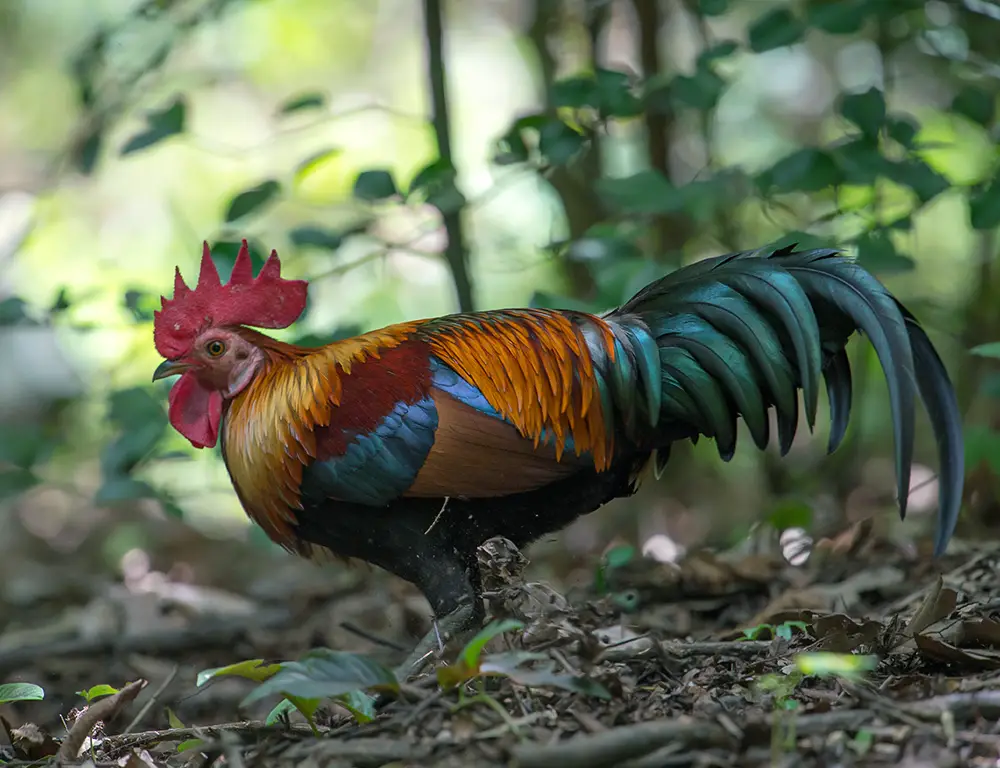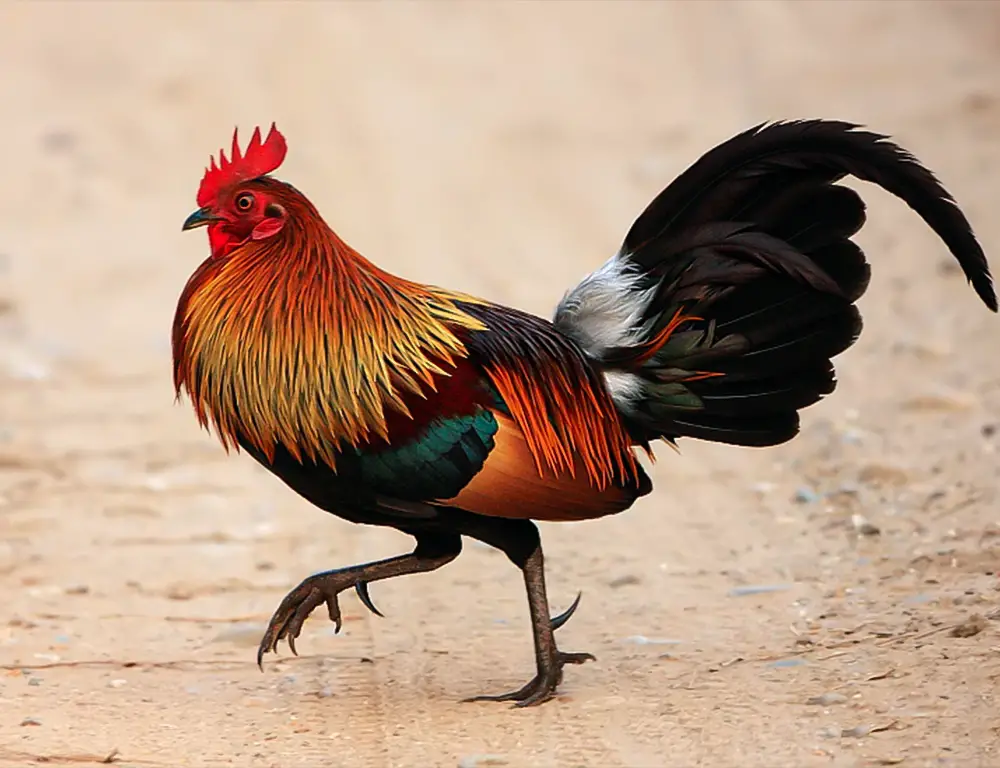Nestled within the lush canopies of Southeast Asia’s dense forests, the Red Junglefowl (Gallus gallus) is a symbol of primitive elegance and untamed beauty.
This elusive bird captivates scientists and nature enthusiasts with its vibrant plumage and proud demeanor.
Believed to be the ancestor of the domestic chicken, the Red Junglefowl’s legacy traces back thousands of years, offering a glimpse into the evolutionary journey of poultry worldwide.
Venturing into the depths of its habitat, one encounters a realm teeming with life and mystery. From the echoing calls resonating through the thick foliage to the intricate dance of courtship rituals, every aspect of the Red Junglefowl’s existence exudes vitality and resilience.
Yet, despite its resilience, the species faces growing threats from habitat loss and human encroachment. Join us on an expedition through the vibrant realms of Southeast Asia as we unravel the secrets of the Red Junglefowl.
Key Identifying Characteristics of the Red Junglefowl

The Red Junglefowl possesses several key identifying characteristics that distinguish it from other bird species, including its vibrant plumage, distinctive calls, and behavioral traits.
Let’s delve into these features to understand this fascinating bird better.
Plumage
One of the most striking features of the Red Junglefowl is its colorful plumage. Males typically exhibit a combination of glossy, iridescent feathers in shades of red, orange, and gold, with dark markings accentuating their wings and tails.
The vivid colors serve as a visual display during courtship rituals, helping males attract mates and establish dominance within their social hierarchy.
In contrast, females have more subdued plumage, consisting of brownish tones with barring to provide camouflage while nesting and foraging on the forest floor.
Size and Shape
Red Junglefowl are medium-sized birds, with males generally more prominent than females. On average, males weigh around 1-1.5 kilograms (2.2-3.3 pounds), while females are slightly lighter, ranging from 0.7-1 kilogram (1.5-2.2 pounds).
Both sexes have a compact, agile build, adapted for maneuvering through dense vegetation and easily navigating their forest habitat.
Their long legs and strong claws enable them to scratch the forest floor for food, while their streamlined bodies facilitate swift flight to evade predators.
Crest and Wattles
Male Red Junglefowl sports a distinctive crest of feathers on their heads, which they can raise or lower depending on their mood or level of arousal.
This crest serves as a visual cue during displays of aggression or courtship, helping to communicate their intentions to other members of their flock.
Additionally, both males and females have fleshy red wattles, or fleshy lobes, on their faces, which may play a role in thermoregulation or social signaling.
Voice
Males emit a series of loud, raucous calls consisting of crows, cackles, and clucks, particularly during the breeding season when they are vying for the attention of females and defending their territory from rival males.
These calls can carry over long distances through the forest, serving as a means of communication and territory advertisement.
Conversely, females produce softer, more subdued clucking sounds, especially when leading their chicks or signaling danger.
Behavior
Red Junglefowl are diurnal birds, meaning they are most active during the day. They spend much of their time foraging for food on the forest floor, where they feed on a varied diet of seeds, fruits, insects, and small invertebrates.
Their keen sense of sight and hearing helps them detect potential threats, such as predators or rival males, allowing them to react swiftly to avoid danger.
During the breeding season, males engage in elaborate courtship displays, including puffing out their chests, erecting their crests, and strutting around while emitting vocalizations to attract females.
Habitat and Range
Red Junglefowl are native to Southeast Asia’s tropical and subtropical forests, including countries such as India, Indonesia, Thailand, and Malaysia.
They prefer dense, moist forests with ample ground cover and access to water sources, where they can find food and shelter while avoiding predators.
However, they have also adapted to human-modified landscapes, including agricultural areas and even urban environments, where they may scavenge for food and roost in trees or buildings.
What Is the Taxonomic Level and Life History of the Red Junglefowl?

The Red Junglefowl is a captivating bird native to the dense forests of Southeast Asia. Let’s explore its taxonomy, range, life history, and conservation status to understand this iconic species better.
Taxonomy
| Taxonomy Level | Classification |
| Kingdom | Animalia |
| Phylum | Chordata |
| Class | Aves |
| Order | Galliformes |
| Family | Phasianidae |
| Genus | Gallus |
| Species | Gallus gallus |
Range Map

The Red Junglefowl (Gallus gallus) is native to Southeast Asia’s tropical and subtropical forests, including countries such as India, Indonesia, Thailand, and Malaysia.
Food Habits
Red Junglefowl have an omnivorous diet of seeds, fruits, insects, and small invertebrates. They forage primarily on the forest floor, using their keen eyesight and scratching abilities to uncover food items.
Nesting
| Nesting Habit | Description |
| Nest Location | Typically on the ground, concealed within vegetation such as grass or leaf litter. |
| Nest Structure | Simple depression lined with leaves, feathers, and other soft materials. |
| Clutch Size | Varied, typically 4-7 eggs per clutch. |
| Incubation Period | Around 21 days, with both parents sharing incubation duties. |
| Chick Rearing | Chicks are precocial and leave the nest shortly after hatching, following their mother and learning to forage for food. |
Breeding
Red Junglefowl are monogamous during the breeding season. Males attract mates through elaborate courtship displays, including puffing out their chests, erecting their crests, and emitting vocalizations.
After mating, females lay eggs in concealed nests on the forest floor, where both parents share incubation duties. Chicks hatch after around 21 days and are precocial, meaning they can independently move shortly after hatching.
They follow their mother and learn essential survival skills such as foraging and avoiding predators.
Conservation Status
The conservation status of the Red Junglefowl is of Least Concern, according to the International Union for Conservation of Nature (IUCN).
However, habitat loss and fragmentation due to deforestation, agriculture, and urbanization pose significant threats to their populations.
Conservation efforts focus on habitat protection, sustainable forest management, and raising awareness about preserving biodiversity.
Diseases and Treatments
Red Junglefowl are susceptible to various diseases and parasites, including avian influenza, Newcastle disease, and mites.
Monitoring and disease management programs are essential for maintaining healthy populations, particularly in areas where they coexist with domestic poultry.
Vaccination, biosecurity measures, and habitat management are strategies used to prevent and control disease outbreaks and ensure the well-being of wild Red Junglefowl populations.
7 Fun Facts About the Red Junglefowl
From its vibrant plumage to fascinating behaviors, the Red Junglefowl (Gallus gallus) boasts a plethora of intriguing characteristics. Let’s delve into some fun facts about this iconic bird:
1. Ancestor of the Domestic Chicken
The Red Junglefowl is widely believed to be the primary ancestor of the domestic chicken (Gallus gallus domesticus).
Through selective breeding, humans have transformed the wild Red Junglefowl into the diverse array of chicken breeds seen today, ranging from bantams to broilers.
2. Colorful Plumage
Male Red Junglefowl flaunts a dazzling array of colors, including vibrant red, orange, and gold feathers accented with dark markings on their wings and tails.
These vivid hues serve as visual displays during courtship rituals, helping males attract mates and establish dominance within their social hierarchy.
3. Elaborate Courtship Displays
During the breeding season, male Red Junglefowl engage in elaborate courtship displays to woo females. These displays may include puffing out their chest, erecting their crest, and strutting around while emitting loud vocalizations to impress potential mates.
4. Diverse Vocalizations
Red Junglefowl are known for their diverse vocalizations, which range from loud crows and cackles to softer clucks and purrs.
Males use these calls to communicate with other flock members, advertise their territory, and attract mates during the breeding season.
5. Omnivorous Diet
Red Junglefowl has an omnivorous diet, feeding on various seeds, fruits, insects, and small invertebrates.
They forage primarily on the forest floor, using their sharp eyesight and scratching abilities to uncover food items hidden beneath leaves and debris.
6. Precocial Chicks
Red Junglefowl chicks are precocial, meaning they are born with their eyes open and are capable of independent movement shortly after hatching.
They follow their mother closely, learning essential survival skills such as foraging for food and avoiding predators early on.
7. Adaptability to Human-modified Landscapes
While the Red Junglefowl is native to dense forests, it has shown remarkable adaptability to human-modified landscapes.
These birds can be found foraging in agricultural areas, urban parks, and even suburban neighborhoods, where they scavenge for food and roost in trees or buildings.
FAQs
What is the difference between Red Junglefowl and domestic chickens?
While they share similar physical characteristics, such as colorful plumage, wild Red Junglefowl exhibit more vibrant colors and are adapted to life in dense forest habitats.
Domestic chickens have been selectively bred for various traits, resulting in multiple breeds suited to different purposes.
Where can Red Junglefowl be found in the wild?
Red Junglefowl are native to Southeast Asia’s tropical and subtropical forests, including countries like India, Indonesia, Thailand, and Malaysia. They prefer dense, moist forests with ample ground cover and access to water sources.
Are Red Junglefowl endangered?
No, Red Junglefowl are not considered endangered. They are classified as “Least Concern” by the International Union for Conservation of Nature (IUCN).
However, habitat loss and fragmentation due to deforestation and human activities threaten their populations in certain areas.
What do Red Junglefowl eat?
Red Junglefowl have an omnivorous diet, feeding on various seeds, fruits, insects, and small invertebrates. They forage primarily on the forest floor, using their keen eyesight and scratching abilities to uncover food items hidden beneath leaves and debris.
How does Red Junglefowl communicate?
Red Junglefowl communicate through vocalizations, including loud crows, cackles, and clucks.
Males use these calls to establish territory, attract mates during breeding, and communicate with other flock members.
Additionally, visual displays include puffing out their chest and erecting their crest.
Conclusion
The Red Junglefowl stands as a testament to the resilience and adaptability of wildlife in the face of environmental challenges.
Its vibrant plumage, distinctive calls, and intricate behaviors offer a window into the rich tapestry of life within Southeast Asia’s forests.
As a species with deep historical and cultural significance, the Red Junglefowl reminds us of our interconnectedness with the natural world and the importance of preserving biodiversity.
Despite facing threats such as habitat loss and human encroachment, efforts to conserve and protect the Red Junglefowl and its habitat are underway.
Through research, education, and sustainable management practices, we can work towards ensuring the long-term survival of this iconic species and the ecosystems it inhabits.
By safeguarding the Red Junglefowl, we preserve a symbol of wild beauty and contribute to the broader conservation of biodiversity and the planet’s ecological balance.